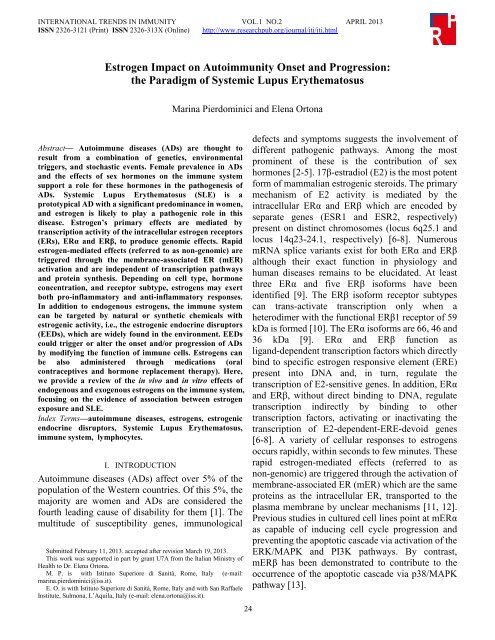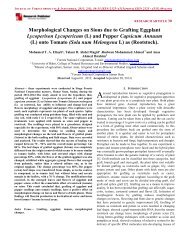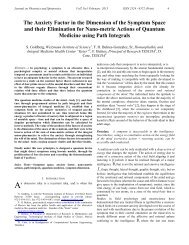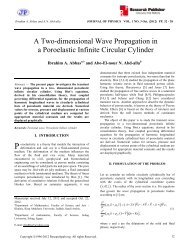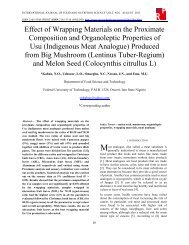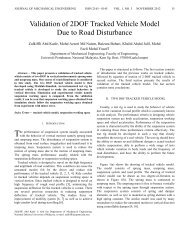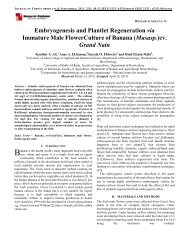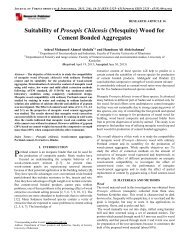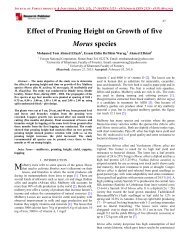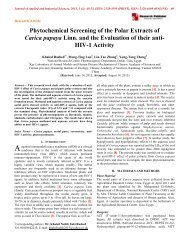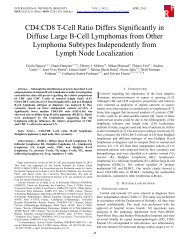Estrogen Impact on Autoimmunity Onset and Progression: the ...
Estrogen Impact on Autoimmunity Onset and Progression: the ...
Estrogen Impact on Autoimmunity Onset and Progression: the ...
- No tags were found...
You also want an ePaper? Increase the reach of your titles
YUMPU automatically turns print PDFs into web optimized ePapers that Google loves.
INTERNATIONAL TRENDS IN IMMUNITY VOL.1 NO.2 APRIL 2013ISSN 2326-3121 (Print) ISSN 2326-313X (Online) http://www.researchpub.org/journal/iti/iti.html<str<strong>on</strong>g>Estrogen</str<strong>on</strong>g> <str<strong>on</strong>g>Impact</str<strong>on</strong>g> <strong>on</strong> <strong>Autoimmunity</strong> <strong>Onset</strong> <strong>and</strong> Progressi<strong>on</strong>:<strong>the</strong> Paradigm of Systemic Lupus Ery<strong>the</strong>matosusMarina Pierdominici <strong>and</strong> Elena Ort<strong>on</strong>aAbstract— Autoimmune diseases (ADs) are thought toresult from a combinati<strong>on</strong> of genetics, envir<strong>on</strong>mentaltriggers, <strong>and</strong> stochastic events. Female prevalence in ADs<strong>and</strong> <strong>the</strong> effects of sex horm<strong>on</strong>es <strong>on</strong> <strong>the</strong> immune systemsupport a role for <strong>the</strong>se horm<strong>on</strong>es in <strong>the</strong> pathogenesis ofADs. Systemic Lupus Ery<strong>the</strong>matosus (SLE) is aprototypical AD with a significant predominance in women,<strong>and</strong> estrogen is likely to play a pathogenic role in thisdisease. <str<strong>on</strong>g>Estrogen</str<strong>on</strong>g>’s primary effects are mediated bytranscripti<strong>on</strong> activity of <strong>the</strong> intracellular estrogen receptors(ERs), ERα <strong>and</strong> ERβ, to produce genomic effects. Rapidestrogen-mediated effects (referred to as n<strong>on</strong>-genomic) aretriggered through <strong>the</strong> membrane-associated ER (mER)activati<strong>on</strong> <strong>and</strong> are independent of transcripti<strong>on</strong> pathways<strong>and</strong> protein syn<strong>the</strong>sis. Depending <strong>on</strong> cell type, horm<strong>on</strong>ec<strong>on</strong>centrati<strong>on</strong>, <strong>and</strong> receptor subtype, estrogens may exertboth pro-inflammatory <strong>and</strong> anti-inflammatory resp<strong>on</strong>ses.In additi<strong>on</strong> to endogenous estrogens, <strong>the</strong> immune systemcan be targeted by natural or syn<strong>the</strong>tic chemicals wi<strong>the</strong>strogenic activity, i.e., <strong>the</strong> estrogenic endocrine disruptors(EEDs), which are widely found in <strong>the</strong> envir<strong>on</strong>ment. EEDscould trigger or alter <strong>the</strong> <strong>on</strong>set <strong>and</strong>/or progressi<strong>on</strong> of ADsby modifying <strong>the</strong> functi<strong>on</strong> of immune cells. <str<strong>on</strong>g>Estrogen</str<strong>on</strong>g>s canbe also administered through medicati<strong>on</strong>s (oralc<strong>on</strong>traceptives <strong>and</strong> horm<strong>on</strong>e replacement <strong>the</strong>rapy). Here,we provide a review of <strong>the</strong> in vivo <strong>and</strong> in vitro effects ofendogenous <strong>and</strong> exogenous estrogens <strong>on</strong> <strong>the</strong> immune system,focusing <strong>on</strong> <strong>the</strong> evidence of associati<strong>on</strong> between estrogenexposure <strong>and</strong> SLE.Index Terms—autoimmune diseases, estrogens, estrogenicendocrine disruptors, Systemic Lupus Ery<strong>the</strong>matosus,immune system, lymphocytes.I. INTRODUCTIONAutoimmune diseases (ADs) affect over 5% of <strong>the</strong>populati<strong>on</strong> of <strong>the</strong> Western countries. Of this 5%, <strong>the</strong>majority are women <strong>and</strong> ADs are c<strong>on</strong>sidered <strong>the</strong>fourth leading cause of disability for <strong>the</strong>m [1]. Themultitude of susceptibility genes, immunologicalSubmitted February 11, 2013. accepted after revisi<strong>on</strong> March 19, 2013.This work was supported in part by grant U7A from <strong>the</strong> Italian Ministry ofHealth to Dr. Elena Ort<strong>on</strong>a.M. P. is with Istituto Superiore di Sanità, Rome, Italy (e-mail:marina.pierdominici@iss.it).E. O. is with Istituto Superiore di Sanità, Rome, Italy <strong>and</strong> with San RaffaeleInstitute, Sulm<strong>on</strong>a, L’Aquila, Italy (e-mail: elena.ort<strong>on</strong>a@iss.it).24defects <strong>and</strong> symptoms suggests <strong>the</strong> involvement ofdifferent pathogenic pathways. Am<strong>on</strong>g <strong>the</strong> mostprominent of <strong>the</strong>se is <strong>the</strong> c<strong>on</strong>tributi<strong>on</strong> of sexhorm<strong>on</strong>es [2-5]. 17β-estradiol (E2) is <strong>the</strong> most potentform of mammalian estrogenic steroids. The primarymechanism of E2 activity is mediated by <strong>the</strong>intracellular ERα <strong>and</strong> ERβ which are encoded byseparate genes (ESR1 <strong>and</strong> ESR2, respectively)present <strong>on</strong> distinct chromosomes (locus 6q25.1 <strong>and</strong>locus 14q23-24.1, respectively) [6-8]. NumerousmRNA splice variants exist for both ERα <strong>and</strong> ERβalthough <strong>the</strong>ir exact functi<strong>on</strong> in physiology <strong>and</strong>human diseases remains to be elucidated. At leastthree ERα <strong>and</strong> five ERβ isoforms have beenidentified [9]. The ERβ isoform receptor subtypescan trans-activate transcripti<strong>on</strong> <strong>on</strong>ly when aheterodimer with <strong>the</strong> functi<strong>on</strong>al ERβ1 receptor of 59kDa is formed [10]. The ERα isoforms are 66, 46 <strong>and</strong>36 kDa [9]. ERα <strong>and</strong> ERβ functi<strong>on</strong> aslig<strong>and</strong>-dependent transcripti<strong>on</strong> factors which directlybind to specific estrogen resp<strong>on</strong>sive element (ERE)present into DNA <strong>and</strong>, in turn, regulate <strong>the</strong>transcripti<strong>on</strong> of E2-sensitive genes. In additi<strong>on</strong>, ERα<strong>and</strong> ERβ, without direct binding to DNA, regulatetranscripti<strong>on</strong> indirectly by binding to o<strong>the</strong>rtranscripti<strong>on</strong> factors, activating or inactivating <strong>the</strong>transcripti<strong>on</strong> of E2-dependent-ERE-devoid genes[6-8]. A variety of cellular resp<strong>on</strong>ses to estrogensoccurs rapidly, within sec<strong>on</strong>ds to few minutes. Theserapid estrogen-mediated effects (referred to asn<strong>on</strong>-genomic) are triggered through <strong>the</strong> activati<strong>on</strong> ofmembrane-associated ER (mER) which are <strong>the</strong> sameproteins as <strong>the</strong> intracellular ER, transported to <strong>the</strong>plasma membrane by unclear mechanisms [11, 12].Previous studies in cultured cell lines point at mERαas capable of inducing cell cycle progressi<strong>on</strong> <strong>and</strong>preventing <strong>the</strong> apoptotic cascade via activati<strong>on</strong> of <strong>the</strong>ERK/MAPK <strong>and</strong> PI3K pathways. By c<strong>on</strong>trast,mERβ has been dem<strong>on</strong>strated to c<strong>on</strong>tribute to <strong>the</strong>occurrence of <strong>the</strong> apoptotic cascade via p38/MAPKpathway [13].
INTERNATIONAL TRENDS IN IMMUNITY VOL.1 NO.2 APRIL 2013ISSN 2326-3121 (Print) ISSN 2326-313X (Online) http://www.researchpub.org/journal/iti/iti.htmlII. ESTROGEN RECEPTORS IN IMMUNE CELLSIntracellular ERs are expressed in all immune celltypes [14, 15]. Particularly, our group has recentlydem<strong>on</strong>strated <strong>the</strong> intracellular expressi<strong>on</strong> of bothERα <strong>and</strong> ERβ in T, B lymphocyte subsets, <strong>and</strong>peripheral NK cells [16]. The ERα46 isoformappeared to be <strong>the</strong> most represented ER inlymphocytes without significant differences am<strong>on</strong>glymphocyte subsets. Although ERβ was expressed inall lymphocyte subsets, our data suggest a lowerexpressi<strong>on</strong> level of this receptor with respect toERα46.The typical physiological level of E2 is extremelylow, in <strong>the</strong> range of 10–900 pg/ml, <strong>and</strong> it varies based<strong>on</strong> <strong>the</strong> age <strong>and</strong> physiological status of <strong>the</strong> individual(i.e., E2 levels are typically less than 100 pg/ml, butjust before ovulati<strong>on</strong> <strong>the</strong>y spike to 800 pg/ml, <strong>and</strong>during <strong>the</strong> third trimester of pregnancy vary from 0.5to 140 ng/ml) [17]. E2 can produce different effectsdepending <strong>on</strong> its c<strong>on</strong>centrati<strong>on</strong> but also <strong>on</strong> <strong>the</strong> type oftarget cell, <strong>the</strong> receptor subtype present <strong>on</strong> a givencell type, <strong>and</strong> <strong>the</strong> timing of administrati<strong>on</strong>. Table Isummarizes <strong>the</strong> most important effects of high <strong>and</strong>low c<strong>on</strong>centrati<strong>on</strong>s of E2 <strong>on</strong> different types ofimmune cells. In brief, at pregnancy levels, E2inhibits pro-inflammatory pathways such as TNFα,IL-1β, IL-6, <strong>and</strong> activity of natural killer (NK) cells,whereas E2 at <strong>the</strong> same c<strong>on</strong>centrati<strong>on</strong> stimulatesanti-inflammatory pathways such as IL-4, IL-10, <strong>and</strong>TGFβ [2]. Additi<strong>on</strong>ally, it enhances <strong>the</strong> number <strong>and</strong>functi<strong>on</strong> of CD4+CD25+ regulatory T cells [18, 19].Surprisingly, no direct effect of E2 <strong>on</strong> Th17 cells orIL-17 producti<strong>on</strong> has been described in humans untilnow, whereas c<strong>on</strong>flicting results have been reportedin animal models where E2, at high c<strong>on</strong>centrati<strong>on</strong>s,ei<strong>the</strong>r enhances [20] or decreases [21] IL-17producti<strong>on</strong>. At lower c<strong>on</strong>centrati<strong>on</strong>s, E2 stimulatesTNFα, IFN-γ, IL-1β, <strong>and</strong> activity of NK cells [2].Differently, E2 stimulates antibody producti<strong>on</strong> by Bcells throughout <strong>the</strong> c<strong>on</strong>centrati<strong>on</strong> range [2].Regarding cell surface expressi<strong>on</strong> of ERs <strong>on</strong> humanlymphocytes, previously reported data, obtainedusing E2 covalently bound to bovine serum albumin(BSA)-FITC, indicated that an estrogen bindingprotein exists <strong>on</strong> <strong>the</strong> plasma membrane of humanlymphoblastoid B cells [22]. More recently, by usingepitope-binding technologies, we dem<strong>on</strong>strated <strong>the</strong>cell surface expressi<strong>on</strong> of a functi<strong>on</strong>ally activeERα46 isoform, but not of ERβ, <strong>on</strong> lymphocytes,supporting <strong>the</strong> idea that E2 level fluctuati<strong>on</strong>s may beassociated with a prompt lymphocyte resp<strong>on</strong>se [16].In particular, E2-BSA significantly increased CD4+<strong>and</strong> CD8+ T lymphocyte proliferati<strong>on</strong> in resp<strong>on</strong>se toanti-CD3 m<strong>on</strong>ocl<strong>on</strong>al antibody <strong>and</strong> IFN-γ producti<strong>on</strong>by NK cells. Fur<strong>the</strong>r studies are needed to a betterdefiniti<strong>on</strong> of mER expressi<strong>on</strong> <strong>and</strong> its signaltransducti<strong>on</strong> pathway in different lymphocytesubpopulati<strong>on</strong>s. In this regard, <strong>the</strong> development of anovel transgenic mouse in which mER-signaling isblocked [23] may be helpful to elucidate how mERsignaling c<strong>on</strong>tributes to <strong>the</strong> transcripti<strong>on</strong>al functi<strong>on</strong>sof intracellular ERs <strong>and</strong> could lead to identify <strong>the</strong>rapid ER signaling pathway as a potential target fornovel <strong>the</strong>rapeutic agents.TABLE IESTROGEN EFFECTS ON IMMUNE CELLS↑, indicates stimulati<strong>on</strong> by E2, ↓ indicates inhibiti<strong>on</strong> by E2III. SYSTEMIC LUPUS ERYTHEMATOSUS (SLE)Sex horm<strong>on</strong>es, including estrogens, have beenproposed to play an important role in autoimmunity,[14, 24-26], although <strong>the</strong> precise mechanisms bywhich estrogens modulate <strong>the</strong> cellular <strong>and</strong> molecularprocesses that govern immune homeostasis are far tobe fully elucidated. A prototypic autoimmunedisease is SLE which is a multifactorial <strong>and</strong> highlypolymorphic systemic AD with a higher incidence inwomen than man [27]. Pre-menopausal women haveSLE incidence rates of 9:1 when compared toage-matched males [28]. These rates decline to 5:1after menopause. In <strong>the</strong> pre-adolescent populati<strong>on</strong>,where estrogen levels are more similar betweengenders, females have SLE with a frequency of 3:1when compared to males.25
INTERNATIONAL TRENDS IN IMMUNITY VOL.1 NO.2 APRIL 2013ISSN 2326-3121 (Print) ISSN 2326-313X (Online) http://www.researchpub.org/journal/iti/iti.htmlSLE affects multiple organs, including skin, muscle,joints, <strong>and</strong> vital internal organs, such as kidneys <strong>and</strong>heart. Despite <strong>the</strong> number of studies reported so far,<strong>the</strong> etiology of SLE remains unknown. However, it islikely that <strong>the</strong> complex interacti<strong>on</strong> between genetic,envir<strong>on</strong>mental (e.g., infectious agents, UV light,drugs), <strong>and</strong> horm<strong>on</strong>al factors promotes <strong>the</strong> immunedysfuncti<strong>on</strong> underlying <strong>the</strong> pathogenesis of <strong>the</strong>disease [29, 30]. SLE is characterized byautoantibody producti<strong>on</strong> by dysregulated B cells,target organ infiltrati<strong>on</strong> by inflammatory T cells, <strong>and</strong>aberrant immune cell activati<strong>on</strong> due to abnormalantigen presenting cell functi<strong>on</strong>. Theautoantigen-autoantibody interacti<strong>on</strong> triggers <strong>the</strong>formati<strong>on</strong> of immune complexes that, <strong>on</strong>ce deposited,cause tissue injury. In particular, immune complexes,c<strong>on</strong>taining autoantibodies against DNA <strong>and</strong>rib<strong>on</strong>ucleoproteins, activate Toll like receptors(TLR)7 <strong>and</strong> TLR9 <strong>on</strong> dendritic cells <strong>and</strong> B cells, <strong>and</strong>this event leads to enhanced autoantibody producti<strong>on</strong><strong>and</strong> IFN-α secreti<strong>on</strong>, which is suggested to be keymodulator in <strong>the</strong> pathogenesis of SLE [31].As stated above, <strong>the</strong> incidence of SLE increases afterpuberty <strong>and</strong> flares are more comm<strong>on</strong> during <strong>the</strong>pre-menstrual period <strong>and</strong> pregnancy, time frameswith increased estrogen levels. Additi<strong>on</strong>ally, <strong>the</strong>disease is more prevalent in some ethnic groups, suchas Afro-Americans <strong>and</strong> Asians. Interestingly,estrogen levels were shown to be higher in Asian(Japanese) <strong>and</strong> African (Bantu) women than inCaucasian women [32]. This evidence implies animportant role of estrogens in SLE pathogenesis but<strong>the</strong> mechanisms involved have not been fullyelucidated [33, 34].IV. ESTROGENS AND ERs IN SLEIn vitro studies revealed that lymphocytes from SLEpatients exhibit an increased sensitivity to E2 [33]. Asummary of in vitro effects of E2 <strong>on</strong> lymphocytesfrom SLE patients is reported in Table II. It isimportant to underline that all <strong>the</strong> studies describedbelow were performed with physiological E2c<strong>on</strong>centrati<strong>on</strong>s. E2 in vitro enhanced total IgGproducti<strong>on</strong> as well as anti-dsDNA autoantibodyproducti<strong>on</strong> in SLE patients by promoting B cellactivity <strong>and</strong> by increasing IL-10 producti<strong>on</strong> inm<strong>on</strong>ocytes [35]. Autoantibodies were not secreted byB lymphocytes from healthy d<strong>on</strong>ors treated in <strong>the</strong>same way [35]. Additi<strong>on</strong>ally, mRNA expressi<strong>on</strong> of<strong>the</strong> T cell activati<strong>on</strong> markers calcineurin <strong>and</strong> CD154were up-regulated by E2 in SLE but not in normal Tcells through both ERα <strong>and</strong> ERβ [36-39]. Calcineurin<strong>and</strong> CD154 mRNA expressi<strong>on</strong> was alsodown-regulated in SLE patients treated with <strong>the</strong> ERantag<strong>on</strong>ist Fulvestrant (Faslodex) in associati<strong>on</strong>which a reducti<strong>on</strong> of disease activity [40].Interestingly, although E2 induced ERKphosphorylati<strong>on</strong> in a wide variety of cell types, itsuppressed ERK activati<strong>on</strong> in activated T cells frompatients with inactive or mild disease but not frompatients with active disease [41]. Whe<strong>the</strong>rE2-dependent dampening of ERK signalling isimportant for maintaining inactive disease remains tobe elucidated. E2 was also found to inhibits apoptosisin activated T cells, this favouring <strong>the</strong> persistence ofautoreactive cl<strong>on</strong>es [42]. On <strong>the</strong> o<strong>the</strong>r h<strong>and</strong>, Rastin etal. [43] showed that E2 increased <strong>the</strong> mRNAexpressi<strong>on</strong> level of FasL <strong>and</strong> caspase-8 in resting Tlymphocytes.More recently, E2 has been found to alter differentsignaling pathways in SLE T cells, that areassociated with disease <strong>on</strong>set <strong>and</strong> progressi<strong>on</strong>,including IFN-α signaling [44]. A fur<strong>the</strong>r potentialmechanism of acti<strong>on</strong> of E2 in SLE pathogenesis hasbeen suggested by Young et al. [45] who found that<strong>the</strong> signaling <strong>and</strong> transcripti<strong>on</strong> molecule ZAS3,which is involved in regulating inflammatoryresp<strong>on</strong>ses, was overexpressed in peripheral bloodm<strong>on</strong><strong>on</strong>uclear cells (PBMC) from SLE patients <strong>and</strong> itwas up-regulated by E2. E2 inducti<strong>on</strong> of ZAS3requires ERα. Intriguingly, ZAS3 <strong>and</strong> E2 both targetNFκB <strong>and</strong> lead to its functi<strong>on</strong>al repressi<strong>on</strong>, just asobserved in SLE [46]. The expressi<strong>on</strong> of ER has beeninvestigated in T cells from SLE patients todetermine whe<strong>the</strong>r <strong>the</strong> hyper resp<strong>on</strong>siveness of SLElymphocytes to E2 could be ascribed to differences inER levels. No alterati<strong>on</strong>s in <strong>the</strong> expressi<strong>on</strong> of ERα orERβ (both at mRNA <strong>and</strong> protein levels) weredetected in SLE [39, 47, 48], although ERα proteinwas found to exhibit a greater degree of variati<strong>on</strong>than that in c<strong>on</strong>trol T cells [39].The c<strong>on</strong>tributi<strong>on</strong>s of microRNA (miRNA) topathogenesis of SLE are beginning to be uncovered[49]. miRNAs are short (19–24 nucleotides in length)n<strong>on</strong>-coding RNAs that regulate messenger RNA(mRNA) or protein levels ei<strong>the</strong>r by promotingmRNA degradati<strong>on</strong> or by attenuating proteintranslati<strong>on</strong>. Evidence suggests that estrogens may26
INTERNATIONAL TRENDS IN IMMUNITY VOL.1 NO.2 APRIL 2013ISSN 2326-3121 (Print) ISSN 2326-313X (Online) http://www.researchpub.org/journal/iti/iti.htmlc<strong>on</strong>tribute to <strong>the</strong> gender bias in SLE modulatingselected miRNA expressi<strong>on</strong> [50]. miR-146a, whichis a negative regulator of <strong>the</strong> IFN-α pathway, <strong>and</strong>miR125a, which negatively regulates <strong>the</strong>inflammatory chemokine RANTES, wereprofoundly decreased in PBMC from patients withSLE as compared to healthy d<strong>on</strong>ors [51, 52].C<strong>on</strong>versely, miR21 <strong>and</strong> miR148a, which c<strong>on</strong>tributeto DNA hypomethylati<strong>on</strong> in lupus CD4+ T cells [53],were found up-regulated [54]. Notably, Dai et al. [55]observed that miR148a was up-regulated whereasmiR146a <strong>and</strong> miR125a were down-regulated by E2,at least in splenocytes from estrogen-treated mice.Toge<strong>the</strong>r, <strong>the</strong> aforementi<strong>on</strong>ed studies show thatmiR-146a, miR-125a, <strong>and</strong> miR-148A aredysregulated in SLE c<strong>on</strong>tributing to diseasepathogenesis <strong>and</strong> estrogens regulate <strong>the</strong>se miRNAexpressi<strong>on</strong> [50].As stated above, ERα <strong>and</strong> ERβ are encoded by <strong>the</strong>ESR1 <strong>and</strong> ESR2 genes which are both polymorphic.rs2234693 <strong>and</strong> rs4986938 are two single nucleotidepolymorphisms (SNPs) whose C <strong>and</strong> A variantsincrease transcripti<strong>on</strong> of ESR1 <strong>and</strong> ESR2,respectively. Although no associati<strong>on</strong>s betweenrs2234693 genotype <strong>and</strong> SLE were found, thispolymorphism has been suggested to influence <strong>the</strong>risk for particular forms of disease [56-58]. Notably,two studies performed in Asian [57] <strong>and</strong> Caucasian[58] populati<strong>on</strong>s reported that <strong>the</strong> T allele ofrs2234693 (ESR1) was associated with early <strong>on</strong>set ofSLE. C<strong>on</strong>versely, in ano<strong>the</strong>r study, Kisiel et al. [59]reported <strong>the</strong> associati<strong>on</strong> of <strong>the</strong> allele C of rs2234693(ESR1) with juvenile SLE, <strong>and</strong> <strong>the</strong>y also found anassociati<strong>on</strong> of allele A of rs4986938 (ESR2) withadult SLE. In c<strong>on</strong>trast, two genome-wide associati<strong>on</strong>studies in SLE were published but nei<strong>the</strong>r reportedassociati<strong>on</strong> with <strong>the</strong> ESR1 or ESR2 variants [60, 61].In summary, genetic variati<strong>on</strong> in estrogen-relatedpathways might be important for SLE development,but this field needs fur<strong>the</strong>r investigati<strong>on</strong>s taking intoaccount clinical characteristics of patients.Studies of mice models revealed that lupus alsopredominates in females. Moreover, ovariectomizedfemale (NZBxNZW)F1 mice live l<strong>on</strong>ger <strong>and</strong>castrated males develop an accelerated autoimmunedisease [62]. The role of ERα in lupus-like diseasehas been suggested by different studies. A study in(NZBxNZW)F1 mice that utilized ERα-selective <strong>and</strong>ERβ-selective ag<strong>on</strong>ists indicated that <strong>the</strong> ERα27activati<strong>on</strong> plays an immunostimulatory role inmurine lupus, whereas <strong>the</strong> ERβ activati<strong>on</strong> has mildimmunosuppressive effects [63]. The key role ofERα, but not ERβ, in <strong>the</strong> pathogenesis of lupus wasfur<strong>the</strong>r c<strong>on</strong>firmed in experiments with ERα −/−NZM2410 <strong>and</strong> ERα −/− MRL/lpr lupus pr<strong>on</strong>e mice.ERα-deficient mice manifested significantly lesspathologic renal disease <strong>and</strong> proteinuria <strong>and</strong> hadsignificantly prol<strong>on</strong>ged survival compared towild-type mice [64]. Since anti-dsDNA antibodylevels <strong>and</strong> number <strong>and</strong> percentage of B/T cells werenot significantly impacted by ERα genotype, <strong>the</strong>authors hypo<strong>the</strong>sized that <strong>the</strong> primary benefit of ERαdeficiency in lupus nephritis was via modulati<strong>on</strong> of<strong>the</strong> innate immune resp<strong>on</strong>se. In a subsequent study,<strong>the</strong>y found that ERαKO-derived cells have asignificantly reduced inflammatory resp<strong>on</strong>se afterstimulati<strong>on</strong> with TLR ag<strong>on</strong>ists [65]. In fact, in <strong>the</strong>absence of ERα, <strong>the</strong> inflammatory resp<strong>on</strong>se to TLR9stimulati<strong>on</strong> was significantly blunted. Additi<strong>on</strong>ally,ERα was required for TLR-induced stimulati<strong>on</strong> ofIL-23R expressi<strong>on</strong>, which may have paracrine <strong>and</strong>autocrine effects <strong>on</strong> T cells <strong>and</strong> dendritic cellsinvolved in <strong>the</strong> IL-23/IL-17 inflammatory pathway[65] . In c<strong>on</strong>trast, ERβ deficiency had no effect <strong>on</strong>lupus activity [64]. Overall, <strong>the</strong>se data implicate <strong>the</strong>role of estrogen <strong>and</strong> ERα in <strong>the</strong> progressi<strong>on</strong> oflupus-like disease.V. ESTROGEN RECEPTOR MODULATORSA. Envir<strong>on</strong>mental estrogensIn additi<strong>on</strong> to <strong>the</strong> endogenous estrogens, <strong>the</strong> immunesystem can be targeted by natural (phytoestrogens<strong>and</strong> mycoestrogens) or syn<strong>the</strong>tic (xenoestrogens)compounds with estrogenic activity, i.e., <strong>the</strong>estrogenic endocrine disruptors (EEDs) [66, 67].Xenoestrogens are widely found in plastics (e.g.,bisphenol-A, BPA), detergents <strong>and</strong> surfactants (e.g.,octylphenol, n<strong>on</strong>ylphenol), pesticides (e.g.,methoxychlor, chlordec<strong>on</strong>e, <strong>and</strong>o,p’-dichlorodiphenyltrichloroethane, DDT), <strong>and</strong>industrial chemicals (e.g.,2,3,7,8-tetrachlorodibenzo-p-dioxin, TCDD). Thethree major classes of phytoestrogens are isoflav<strong>on</strong>es,coumestans, <strong>and</strong> lignans. Genistein <strong>and</strong> daidzein are<strong>the</strong> major bioactive isoflav<strong>on</strong>es, principally availablein soybean <strong>and</strong> soy products. It is worthy to underline
INTERNATIONAL TRENDS IN IMMUNITY VOL.1 NO.2 APRIL 2013ISSN 2326-3121 (Print) ISSN 2326-313X (Online) http://www.researchpub.org/journal/iti/iti.htmlthat soy is found in up to 60% of processed food,being a food additive <strong>and</strong> a meat substitute. Foodsources of coumestans (e.g., coumestrol) includeclover sprouts, alfalfa sprouts, dry split peas, <strong>and</strong>o<strong>the</strong>r legumes [68]. Food sources of lignans includesesame seed, Brassica vegetables <strong>and</strong> olive oil.Zearalen<strong>on</strong>e, produced by Fusarium moulds growing<strong>on</strong> damp [69], is <strong>the</strong> best characterized mycoestrogen,<strong>and</strong> it is a fungal c<strong>on</strong>taminant of corn <strong>and</strong> grains.EEDs are able to exert <strong>the</strong>ir effects through multiplemethods of acti<strong>on</strong>. They have <strong>the</strong> ability to bind avariety of nuclear receptors including ERs [70].Through <strong>the</strong>se interacti<strong>on</strong>s, EEDs are able to alter <strong>the</strong>activity of resp<strong>on</strong>se elements of genes, block naturalhorm<strong>on</strong>es from binding to <strong>the</strong>ir receptors, or in somecases increase <strong>the</strong> activity of endogenous horm<strong>on</strong>eby acting as a horm<strong>on</strong>e ag<strong>on</strong>ist. Although <strong>the</strong>y areless potent than estrogen, l<strong>on</strong>g-term exposure to<strong>the</strong>se compounds could result in accumulati<strong>on</strong> in <strong>the</strong>body fat <strong>and</strong> lead to key alterati<strong>on</strong>s in <strong>the</strong> immunesystem [67, 71]. Epidemiological evidence <strong>and</strong>studies in animal models suggest a link betweenEEDs exposure <strong>and</strong> increasing prevalence of ADs. Infact, by interacting <strong>and</strong> modifying <strong>the</strong> functi<strong>on</strong><strong>and</strong>/or resp<strong>on</strong>se of immune cells, EEDs could trigger,aggravate, or alter <strong>the</strong> development <strong>and</strong>/orprogressi<strong>on</strong> of ADs. Because of <strong>the</strong> predominance offemales in ADs, <strong>the</strong> role of estrogens of <strong>the</strong>rapeuticsources, i.e., oral c<strong>on</strong>traceptives <strong>and</strong> horm<strong>on</strong>ereplacement <strong>the</strong>rapy, should also be taken intoc<strong>on</strong>siderati<strong>on</strong>. Here, we summarize those studiesinvestigating <strong>the</strong> potential effects of EEDs <strong>on</strong>autoimmunity focusing <strong>on</strong> SLE (Table III). To notethat <strong>the</strong>se studies do not have a direct counterpart inhumans, an aspect which warrants intenseinvestigati<strong>on</strong>.XenoestrogensBPA is a classic example of an estrogen mimic [72,73]. It binds as an ag<strong>on</strong>ist to ERβ, albeit with a muchlower affinity ( > 1000-fold) than E2 [74], <strong>and</strong> hasbeen observed to have both ag<strong>on</strong>ist <strong>and</strong> antag<strong>on</strong>istactivity at <strong>the</strong> ERα in vitro [75]. In vitro <strong>and</strong> in vivodata suggest that BPA displays significant effects <strong>on</strong><strong>the</strong> immune system. For instance, BPA has beenshown to increase T cell proliferati<strong>on</strong> <strong>and</strong> Th1/Th2polarizati<strong>on</strong> skewing T cells toward a Th2 phenotype,to increase <strong>the</strong> producti<strong>on</strong> of IgA <strong>and</strong> IgG2a in Bcells, <strong>and</strong> to decrease number of CD4+ CD25+regulatory T cells [72]. Studies of BPA-treated lupusmice are not definitive in <strong>the</strong>ir results. Short termexposure of (NZBxNZW)F1 mice to BPAsuppressed autoimmunity development through areducti<strong>on</strong> of IFN-γ producti<strong>on</strong>, a delay in proteinuriadevelopment, <strong>and</strong> an increase in <strong>the</strong> disease-freeperiod [76]. In a subsequent study, subcutaneousadministrati<strong>on</strong> of BPA for 3 to 4 m<strong>on</strong>ths promotedIgM autoantibody producti<strong>on</strong> by B1 cells inovariectomized (NZBxNZW)F1 mice [77]. Inc<strong>on</strong>trast to BPA, organochlorine pesticides wi<strong>the</strong>strogenic activity such as chlordec<strong>on</strong>e,methoxychlor, <strong>and</strong> DDT were found to speed <strong>the</strong>progressi<strong>on</strong> of lupus in ovariectomized female (NZB× NZW)F1 mice [78]. In particular, a dose-resp<strong>on</strong>sestudy c<strong>on</strong>ducted with chlordec<strong>on</strong>e showed adose-related early appearance of elevatedanti-dsDNA IgG titres <strong>and</strong> immune complexdepositi<strong>on</strong> in <strong>the</strong> kidneys [78]. It is worthwhilenoting that <strong>the</strong> lowest doses of methoxychlor <strong>and</strong>chlordec<strong>on</strong>e used in <strong>the</strong> above menti<strong>on</strong>ed study werebelow <strong>the</strong> oral reference dose (i.e., <strong>the</strong> maximumacceptable oral dose of a toxic substance) establishedby <strong>the</strong> United States Envir<strong>on</strong>mental Protecti<strong>on</strong>Agency for <strong>the</strong>se compounds (for informati<strong>on</strong>c<strong>on</strong>cerning human exposure relevant doses, c<strong>on</strong>sulthttp://www.epa.gov/iris). This suggests that an effect<strong>on</strong> autoimmunity might be a sensitive toxic end point(an effect that occurs at doses lower than o<strong>the</strong>radverse effects) for <strong>the</strong>se compounds, <strong>and</strong> <strong>the</strong>reforeof particular interest for risk assessment.Surprisingly, in a subsequent study examining <strong>the</strong>effects of exposure to high doses of DDT <strong>and</strong> TCDDin female (NZB × NZW)F1 mice, DDT did not showany effect <strong>on</strong> disease development <strong>and</strong> TCDD hadmarked immunosuppressive effects <strong>on</strong> murine SLE[79]. Overall, xenoestrogens, while sharing estrogenag<strong>on</strong>istic <strong>and</strong> antag<strong>on</strong>istic activities, appear to havecompound- <strong>and</strong> tissue-specific effects. It is likely thatvariati<strong>on</strong>s in compound dose, administrati<strong>on</strong> route<strong>and</strong> exposure durati<strong>on</strong> would produce differentresults, which require fur<strong>the</strong>r evaluati<strong>on</strong> in futureworks.PhytoestrogensSoybeans <strong>and</strong> foods c<strong>on</strong>taining soy have significantlevels of isoflav<strong>on</strong>es such as genistein <strong>and</strong> daidzein[80]. In c<strong>on</strong>trast to E2, which binds ERα <strong>and</strong> ERβwith similar affinities, genistein <strong>and</strong> daidzein havegreater affinity for ERβ than ERα [81]. Despite <strong>the</strong>limited estrogenic potency of <strong>the</strong>se compounds,28
INTERNATIONAL TRENDS IN IMMUNITY VOL.1 NO.2 APRIL 2013ISSN 2326-3121 (Print) ISSN 2326-313X (Online) http://www.researchpub.org/journal/iti/iti.html<strong>the</strong>ir high levels in humans under certain nutriti<strong>on</strong>alc<strong>on</strong>diti<strong>on</strong>s could induce significant biologicaleffects. Although an extensive literature showed thatgenistein exerts a dose dependent suppressi<strong>on</strong> ofboth humoral <strong>and</strong> cell-mediated immune resp<strong>on</strong>ses,o<strong>the</strong>r studies reported that genistein or o<strong>the</strong>rphytoestrogens stimulate various aspects of immunefuncti<strong>on</strong> [81, 82]. In autoimmune pr<strong>on</strong>eMRL/Mp-lpr/lpr (MRL/lpr) mice, a soy diet (20%soybean protein <strong>and</strong> 5% soybean oil) was found toexacerbate renal damage, leading to acceleratedproteinuria, elevated serum creatinine, reducedcreatinine clearance, <strong>and</strong> increased glomerulardisease severity [83]. In c<strong>on</strong>trast, a study by H<strong>on</strong>g etal. [84] showed that dietary supplementati<strong>on</strong> of soyisoflav<strong>on</strong>es decreased serum anti-dsDNA IgG <strong>and</strong>anticardiolipin IgG levels, decreased IFN-γsecreti<strong>on</strong> from stimulated T cells, <strong>and</strong> prol<strong>on</strong>ged lifespan in MRL/lpr mice. Similarly, alfalfa sproutethyl acetate extract prol<strong>on</strong>ged <strong>the</strong> life span ofMRL/lpr mice [85]. A mild beneficial effect <strong>on</strong>lupus disease was also exerted by a low dose ofcoumestrol (a phytoestrogen in alfalfa) in (NZB ×NZW)F1 mice [86]. Overall, a generalizedc<strong>on</strong>clusi<strong>on</strong> c<strong>on</strong>cerning whe<strong>the</strong>r phytoestrogens havebeneficial or detrimental immune effects is notpossible. Future studies should take into accountthat a particular exposure could have differentimmune effects depending <strong>on</strong> <strong>the</strong> species, sex, levelof exposure, dosing regimen, <strong>and</strong> age at exposure.B. Oral c<strong>on</strong>traceptives <strong>and</strong> horm<strong>on</strong>e replacement<strong>the</strong>rapyDiethylstilbestrol (DES), a syn<strong>the</strong>tic estrogen withstr<strong>on</strong>g estrogenic activity, was prescribed in <strong>the</strong> pastto pregnant women to ameliorate problems duringpregnancy. It caused adverse effects <strong>on</strong> <strong>the</strong> femaleoffspring known as ‘‘DES daughter syndrome’’ [87].Limited studies in humans have suggested thatDES-exposed women developed a variety of ADs[88]. Animal studies have c<strong>on</strong>firmed that DES hasprofound immunomodulatory effects, including <strong>the</strong>inducti<strong>on</strong> of autoantibodies to cardiolipin [89]. Theseresults are c<strong>on</strong>sistent with findings by Yurino et al.[77] who showed that DES implant resulted inincreased IgG anti-DNA antibody producti<strong>on</strong> <strong>and</strong>immune complex depositi<strong>on</strong> in ovariectomized(NZB × NZW)F1 mice. Even if it is no l<strong>on</strong>ger usedduring pregnancy, exposure to DES may occurthrough c<strong>on</strong>sumpti<strong>on</strong> of milk <strong>and</strong> meat productsfrom animals that received DES as a food additive.17α-ethinyl estradiol (EE), a syn<strong>the</strong>tic analog of E2,is a primary comp<strong>on</strong>ent in horm<strong>on</strong>al c<strong>on</strong>traceptives<strong>and</strong> it is also used in horm<strong>on</strong>e replacement <strong>the</strong>rapy.Clinical trials have now proven that <strong>the</strong> use ofhorm<strong>on</strong>al c<strong>on</strong>traceptive in SLE patients with stablediseases does not increase <strong>the</strong> risk of flare [90].Differently, mild to moderate flares, but not severeflares, are increased in women under horm<strong>on</strong>ereplacement <strong>the</strong>rapy [91]. EE as well as E2 have beenalso identified in <strong>the</strong> envir<strong>on</strong>ment, most prominentlyin <strong>the</strong> aquatic envir<strong>on</strong>ment where <strong>the</strong> main sources ofc<strong>on</strong>taminati<strong>on</strong> are sewage treatment plants <strong>and</strong>agricultural runoff or discharge [92]. EE tends to bepresent in <strong>the</strong> envir<strong>on</strong>ment at much lower levels thanE2 but it is more persistent <strong>and</strong> less volatile [93].Surprisingly, <strong>the</strong>re are no published reports <strong>on</strong> <strong>the</strong>effect of EE in animal pr<strong>on</strong>e to develop ADs <strong>and</strong>many key questi<strong>on</strong>s in relati<strong>on</strong> to potentialimmunologic effects of EE are unanswered. Studiesin animal models are needed to assess whe<strong>the</strong>rsub-acute or chr<strong>on</strong>ic exposure to EE at lowc<strong>on</strong>centrati<strong>on</strong>s affect <strong>the</strong> immune system, whe<strong>the</strong>rEE effects occur equally with regard to age (preversuspost-menopausal women), sex, <strong>and</strong> route ofexposure (subcutaneous <strong>and</strong> oral).C. Anti ERα antibodiesAlterati<strong>on</strong>s of T lymphocyte homeostasis <strong>and</strong> <strong>the</strong>producti<strong>on</strong> of multiple pathogenic autoantibodies,including antibodies specific to ER (anti-ERantibodies), have been repeatedly dem<strong>on</strong>strated in<strong>the</strong> peripheral blood of patients with SLE [29, 94]. Ina recent study, our research group found thatautoantibodies specific to ERα (anti-ERα Abs) werepresent in 45% of SLE patients, <strong>and</strong> <strong>the</strong>y weresignificantly associated to clinical parameters, i.e.,<strong>the</strong> SLE Disease Activity Index <strong>and</strong> arthritis [95].Anti-ERα Abs are able to induce cell activati<strong>on</strong> <strong>and</strong>c<strong>on</strong>sequent apoptotic cell death in resting Tlymphocytes. C<strong>on</strong>versely, <strong>the</strong>y increase proliferati<strong>on</strong>of anti-CD3-stimulated T cells. The pro-apoptoticeffect of anti-ERα Abs <strong>on</strong> T lymphocytes mayc<strong>on</strong>tribute to <strong>the</strong> release of nuclear material in <strong>the</strong>circulati<strong>on</strong> that can represent an important source ofautoantigens if not timely removed. In this regard, animpaired clearance of dying cells is a typical featureof SLE where accumulati<strong>on</strong> of nuclear autoantigens29
INTERNATIONAL TRENDS IN IMMUNITY VOL.1 NO.2 APRIL 2013ISSN 2326-3121 (Print) ISSN 2326-313X (Online) http://www.researchpub.org/journal/iti/iti.htmlmay stimulate <strong>the</strong> immune system to produceautoantibodies [96, 97]. On <strong>the</strong> o<strong>the</strong>r h<strong>and</strong>, <strong>the</strong>increased proliferati<strong>on</strong> of activated T lymphocytestreated with anti-ERα Abs, might c<strong>on</strong>tribute to <strong>the</strong>autoreactive T lymphocyte expansi<strong>on</strong>. Our datasuggest that anti-ERα Abs play a pathogenetic role inSLE interfering with T cell homeostasis. The impactof endogenous <strong>and</strong> EEDs in combinati<strong>on</strong> withanti-ERα Abs remains under scrutiny.TABLE IIISUMMARY OF THE IN VIVO EFFECTS OF ESTROGENICENDOCRINE DISRUPTORS (EEDS) ON DEVELOPMENTOF LUPUS MICETABLE IISUMMARY OF THE IN VITRO EFFECTS OF17β ESTRADIOL (E2) ON LYMPHOCYTESFROM PATIENTS WITH SLE↑, indicates increase; ↓, indicates decrease.BPA, bisphenol-A, DDT, o,p’-dichlorodiphenyltrichloroethane,TCDD, 2,3,7,8-tetrachlorodibenzo-p-dioxin, DES,diethylstilbestrol.↑, indicates up-regulati<strong>on</strong>; ↓, indicates down-regulati<strong>on</strong>.PBMC, peripheral blood m<strong>on</strong><strong>on</strong>uclear cells.VI. FUTURE PROSPECTSDeciphering <strong>the</strong> multi-faceted influences of estrogens<strong>on</strong> <strong>the</strong> regulati<strong>on</strong> of immune resp<strong>on</strong>ses could becritical in elucidating key pathogenic mechanisms inADs <strong>and</strong> could lead to novel <strong>the</strong>rapeutic interventi<strong>on</strong>sfor disease management. Epidemiological evidencesuggests a link between EED exposure <strong>and</strong> increasingprevalence of ADs. However, up to date, <strong>the</strong>re isscant experimental data to link EEDs withautoimmunity. Additi<strong>on</strong>ally, <strong>the</strong>re is no informati<strong>on</strong>about <strong>the</strong> effects <strong>on</strong> humanhealth of <strong>the</strong> interacti<strong>on</strong>s between endogenous <strong>and</strong>exogenous estrogens.Future studies in animal models should address <strong>the</strong>effects of endogenous <strong>and</strong> exogenous estrogens <strong>on</strong><strong>the</strong> immune system at mechanistic levels by studying<strong>the</strong>ir influence <strong>on</strong> <strong>the</strong> lymphocyte functi<strong>on</strong> (e.g.,signaling, proliferati<strong>on</strong>, apoptosis). Whe<strong>the</strong>r EEDscan act <strong>on</strong> mER need to be explored. To note that in<strong>the</strong> experiments reported in this review lupus modelswith a high genetic predispositi<strong>on</strong> for disease wereused. With <strong>the</strong>se models, it is possible to dem<strong>on</strong>stratean effect of estrogens to modify <strong>the</strong> progressi<strong>on</strong> oflupus but not to test whe<strong>the</strong>r <strong>the</strong>y can influence <strong>the</strong><strong>on</strong>set of <strong>the</strong> disease. Answering this questi<strong>on</strong> willrequire testing estrogens in mouse strains with30
INTERNATIONAL TRENDS IN IMMUNITY VOL.1 NO.2 APRIL 2013ISSN 2326-3121 (Print) ISSN 2326-313X (Online) http://www.researchpub.org/journal/iti/iti.htmldiffering genetic background with respect to SLEsusceptibility genes [98] <strong>and</strong> will be important inbetter characterizing <strong>the</strong> autoimmune hazardassociated with <strong>the</strong>ir exposure. Future in vitro studiesin human cells should address i) cellular <strong>and</strong>molecular mechanisms by which EEDs lead to adysregulati<strong>on</strong> of T <strong>and</strong> B cell functi<strong>on</strong>s both inhealthy d<strong>on</strong>ors <strong>and</strong> patients with ADs; ii) <strong>the</strong> abilityof EEDs to act in combinati<strong>on</strong> with an endogenousestrogen via additive, synergistic, or antag<strong>on</strong>isticmechanisms. In c<strong>on</strong>clusi<strong>on</strong>, <strong>the</strong> future challenge willbe to establish whe<strong>the</strong>r estrogens may c<strong>on</strong>tribute, atleast <strong>on</strong> a susceptible background, to development ofautoimmunity, in an individual that might noto<strong>the</strong>rwise develop it, or to <strong>the</strong> worsening of <strong>the</strong>disease in affected individuals. Minor changes inc<strong>on</strong>sumer habits could have drastic effects <strong>on</strong> <strong>the</strong>exposure of <strong>the</strong> general populati<strong>on</strong>; lifestyle changes<strong>and</strong> dietary adjustments could be suggested as anadjuvant <strong>the</strong>rapy for SLE.REFERENCES[1] Mor<strong>on</strong>i L, Bianchi I, <strong>and</strong> Lleo A: Geoepidemiology, gender<strong>and</strong> autoimmune disease. Autoimmun Rev, 11, A386-92, 2012.[2] Straub RH: The complex role of estrogens in inflammati<strong>on</strong>.Endocr Rev, 28, 521-74, 2007.[3] Cutolo M, Sulli A, Capellino S, Villaggio B, M<strong>on</strong>tagna P,Seriolo B, <strong>and</strong> Straub RH: Sex horm<strong>on</strong>es influence <strong>on</strong> <strong>the</strong>immune system: basic <strong>and</strong> clinical aspects in autoimmunity.Lupus, 13, 635-8, 2004.[4] Deroo BJ, <strong>and</strong> Korach KS: <str<strong>on</strong>g>Estrogen</str<strong>on</strong>g> receptors <strong>and</strong> hum<strong>and</strong>isease. J Clin Invest, 116, 561-70, 2006.[5] Rubtsov AV, Rubtsova K, Kappler JW, <strong>and</strong> Marrack P:Genetic <strong>and</strong> horm<strong>on</strong>al factors in female-biased autoimmunity.Autoimmun Rev, 9, 494-8, 2010.[6] Nilss<strong>on</strong> S, Makela S, Treuter E, Tujague M, Thomsen J,Anderss<strong>on</strong> G, Enmark E, Petterss<strong>on</strong> K, Warner M, <strong>and</strong>Gustafss<strong>on</strong> JA: Mechanisms of estrogen acti<strong>on</strong>. Physiol Rev, 81,1535-65, 2001.[7] Gr<strong>on</strong>emeyer H, Gustafss<strong>on</strong> JA, <strong>and</strong> Laudet V: Principles formodulati<strong>on</strong> of <strong>the</strong> nuclear receptor superfamily. Nat Rev DrugDiscov, 3, 950-64, 2004.[8] Heldring N, Pike A, Anderss<strong>on</strong> S, Mat<strong>the</strong>ws J, Cheng G,Hartman J, Tujague M, Strom A, Treuter E, Warner M, <strong>and</strong>Gustafss<strong>on</strong> JA: <str<strong>on</strong>g>Estrogen</str<strong>on</strong>g> receptors: how do <strong>the</strong>y signal <strong>and</strong>what are <strong>the</strong>ir targets. Physiol Rev, 87, 905-31, 2007.[9] Ascenzi P, Bocedi A, <strong>and</strong> Marino M: Structure-functi<strong>on</strong>relati<strong>on</strong>ship of estrogen receptor alpha <strong>and</strong> beta: impact <strong>on</strong>human health. Mol Aspects Med, 27, 299-402, 2006.31[10] Leung YK, Mak P, Hassan S, <strong>and</strong> Ho SM: <str<strong>on</strong>g>Estrogen</str<strong>on</strong>g>receptor (ER)-beta isoforms: a key to underst<strong>and</strong>ing ER-betasignaling. Proc Natl Acad Sci U S A, 103, 13162-7, 2006.[11] Wats<strong>on</strong> CS, <strong>and</strong> Gametchu B: Membrane estrogen <strong>and</strong>glucocorticoid receptors--implicati<strong>on</strong>s for horm<strong>on</strong>al c<strong>on</strong>trol ofimmune functi<strong>on</strong> <strong>and</strong> autoimmunity. Int Immunopharmacol, 1,1049-63, 2001.[12] Levin ER: Plasma membrane estrogen receptors. TrendsEndocrinol Metab, 20, 477-482, 2009.[13] Acc<strong>on</strong>cia F, Totta P, Ogawa S, Cardillo I, Inoue S, Le<strong>on</strong>e S,Trentalance A, Muramatsu M, <strong>and</strong> Marino M: Survival versusapoptotic 17beta-estradiol effect: role of ER alpha <strong>and</strong> ER betaactivated n<strong>on</strong>-genomic signaling. J Cell Physiol, 203, 193-201,2005.[14] Cunningham M, <strong>and</strong> Gilkes<strong>on</strong> G: <str<strong>on</strong>g>Estrogen</str<strong>on</strong>g> receptors inimmunity <strong>and</strong> autoimmunity. Clin Rev Allergy Immunol, 40,66-73, 2011.[15] Pernis AB: <str<strong>on</strong>g>Estrogen</str<strong>on</strong>g> <strong>and</strong> CD4+ T cells. Curr OpinRheumatol, 19, 414-20, 2007.[16] Pierdominici M, Maselli A, Colasanti T, Giammarioli AM,Delunardo F, Vacirca D, Sanchez M, Giovannetti A, Malorni W,<strong>and</strong> Ort<strong>on</strong>a E: <str<strong>on</strong>g>Estrogen</str<strong>on</strong>g> receptor profiles in human peripheralblood lymphocytes. Immunol Lett, 132, 79-85, 2010.[17] Neill JD. Knobil <strong>and</strong> Neill’s physiology of reproducti<strong>on</strong>(3rd ed). Academic Press, New York, 2005.[18] Prieto GA, <strong>and</strong> Rosenstein Y: Oestradiol potentiates <strong>the</strong>suppressive functi<strong>on</strong> of human CD4 CD25 regulatory T cells bypromoting <strong>the</strong>ir proliferati<strong>on</strong>. Immunology, 118, 58-65, 2006.
INTERNATIONAL TRENDS IN IMMUNITY VOL.1 NO.2 APRIL 2013ISSN 2326-3121 (Print) ISSN 2326-313X (Online) http://www.researchpub.org/journal/iti/iti.html[19] Valor L, Teijeiro R, Aristimuno C, Faure F, Al<strong>on</strong>so B, deAndres C, Tejera M, Lopez-Lazareno N, Fern<strong>and</strong>ez-Cruz E,<strong>and</strong> Sanchez-Ram<strong>on</strong> S: Estradiol-dependent perforinexpressi<strong>on</strong> by human regulatory T-cells. Eur J Clin Invest, 41,357-64, 2010.[20] Khan D, Dai R, Karpuzoglu E, <strong>and</strong> Ahmed SA: <str<strong>on</strong>g>Estrogen</str<strong>on</strong>g>increases, whereas IL-27 <strong>and</strong> IFN-gamma decrease, splenocyteIL-17 producti<strong>on</strong> in WT mice. Eur J Immunol, 40, 2549-56,2010.[21] Wang C, Dehghani B, Li Y, Kaler LJ, V<strong>and</strong>enbark AA,<strong>and</strong> Offner H: Oestrogen modulates experimental autoimmuneencephalomyelitis <strong>and</strong> interleukin-17 producti<strong>on</strong> viaprogrammed death 1. Immunology, 126, 329-35, 2009.[22] Tubiana N, Mishal Z, le Caer F, Seigneurin JM, Berthoix Y,Martin PM, <strong>and</strong> Carcass<strong>on</strong>ne Y: Quantificati<strong>on</strong> of oestradiolbinding at <strong>the</strong> surface of human lymphocytes by flowcytofluorimetry. Br J Cancer, 54, 501-4, 1986.[23] Bernelot Moens SJ, Schnitzler GR, Nickers<strong>on</strong> M, Guo H,Ueda K, Lu Q, Ar<strong>on</strong>ovitz MJ, Nickers<strong>on</strong> H, Baur WE, HansenU, Iyer LK, <strong>and</strong> Karas RH: Rapid estrogen receptor signaling isessential for <strong>the</strong> protective effects of estrogen against vascularinjury. Circulati<strong>on</strong>, 126, 1993-2004, 2012.[24] Z<strong>and</strong>man-Goddard G, Peeva E, <strong>and</strong> Shoenfeld Y: Gender<strong>and</strong> autoimmunity. Autoimmun Rev, 6, 366-72, 2007.[25] Ort<strong>on</strong>a E, Margutti P, Matarrese P, Franc<strong>on</strong>i F, <strong>and</strong>Malorni W: Redox state, cell death <strong>and</strong> autoimmune diseases: agender perspective. Autoimmun Rev, 7, 579-84, 2008.[26] Quintero OL, Amador-Patarroyo MJ, M<strong>on</strong>toya-Ortiz G,Rojas-Villarraga A, <strong>and</strong> Anaya JM: Autoimmune disease <strong>and</strong>gender: plausible mechanisms for <strong>the</strong> female predominance ofautoimmunity. J Autoimmun, 38, J109-19, 2011.[27] Ballou SP, Khan MA, <strong>and</strong> Kushner I: Clinical features ofsystemic lupus ery<strong>the</strong>matosus: differences related to race <strong>and</strong>age of <strong>on</strong>set. Arthritis Rheum, 25, 55-60, 1982.[28] Cervera R, Khamashta MA, <strong>and</strong> Hughes GR: TheEuro-lupus project: epidemiology of systemic lupusery<strong>the</strong>matosus in Europe. Lupus, 18, 869-74, 2009.[29] Crispin JC, Liossis SN, Kis-Toth K, Lieberman LA,Kyttaris VC, Juang YT, <strong>and</strong> Tsokos GC: Pathogenesis ofhuman systemic lupus ery<strong>the</strong>matosus: recent advances. TrendsMol Med, 16, 47-57, 2010.[30] Gualtierotti R, Biggioggero M, Penatti AE, <strong>and</strong> Mer<strong>on</strong>i PL:Updating <strong>on</strong> <strong>the</strong> pathogenesis of systemic lupus ery<strong>the</strong>matosus.Autoimmun Rev, 10, 3-7,[31] Elk<strong>on</strong> KB, <strong>and</strong> Wiedeman A: Type I IFN system in <strong>the</strong>development <strong>and</strong> manifestati<strong>on</strong>s of SLE. Curr Opin Rheumatol,24, 499-505, 2012.[32] Hill P, Wynder EL, Helman P, Hickman R, R<strong>on</strong>a G, <strong>and</strong>Kuno K: Plasma horm<strong>on</strong>e levels in different ethnic populati<strong>on</strong>sof women. Cancer Res, 36, 2297-301, 1976.[33] Rider V, <strong>and</strong> Abdou NI: Gender differences inautoimmunity: molecular basis for estrogen effects in systemiclupus ery<strong>the</strong>matosus. Int Immunopharmacol, 1, 1009-24, 2001.[34] Cohen-Solal JF, Jeganathan V, Grimaldi CM, Peeva E, <strong>and</strong>Diam<strong>on</strong>d B: Sex horm<strong>on</strong>es <strong>and</strong> SLE: influencing <strong>the</strong> fate ofautoreactive B cells. Curr Top Microbiol Immunol, 305, 67-88,2006.[35] K<strong>and</strong>a N, Tsuchida T, <strong>and</strong> Tamaki K: <str<strong>on</strong>g>Estrogen</str<strong>on</strong>g>enhancement of anti-double-str<strong>and</strong>ed DNA antibody <strong>and</strong>32immunoglobulin G producti<strong>on</strong> in peripheral blood m<strong>on</strong><strong>on</strong>uclearcells from patients with systemic lupus ery<strong>the</strong>matosus. ArthritisRheum, 42, 328-37, 1999.[36] Rider V, Foster RT, Evans M, Suenaga R, <strong>and</strong> Abdou NI:Gender differences in autoimmune diseases: estrogen increasescalcineurin expressi<strong>on</strong> in systemic lupus ery<strong>the</strong>matosus. ClinImmunol Immunopathol, 89, 171-80, 1998.[37] Rider V, J<strong>on</strong>es S, Evans M, Bassiri H, Afsar Z, <strong>and</strong> AbdouNI: <str<strong>on</strong>g>Estrogen</str<strong>on</strong>g> increases CD40 lig<strong>and</strong> expressi<strong>on</strong> in T cells fromwomen with systemic lupus ery<strong>the</strong>matosus. J Rheumatol, 28,2644-9, 2001.[38] Rider V, Keltner S, <strong>and</strong> Abdou NI: Increasedestrogen-dependent expressi<strong>on</strong> of calcineurin in female SLE Tcells is regulated by multiple mechanisms. J Gend Specif Med,6, 14-21, 2003.[39] Rider V, Li X, Peters<strong>on</strong> G, Daws<strong>on</strong> J, Kimler BF, <strong>and</strong>Abdou NI: Differential expressi<strong>on</strong> of estrogen receptors inwomen with systemic lupus ery<strong>the</strong>matosus. J Rheumatol, 33,1093-101, 2006.[40] Abdou NI, Rider V, Greenwell C, Li X, <strong>and</strong> Kimler BF:Fulvestrant (Faslodex), an estrogen selective receptordownregulator, in <strong>the</strong>rapy of women with systemic lupusery<strong>the</strong>matosus. clinical, serologic, b<strong>on</strong>e density, <strong>and</strong> T cellactivati<strong>on</strong> marker studies: a double-blind placebo-c<strong>on</strong>trolledtrial. J Rheumatol, 35, 797, 2008.[41] Gorjestani S, Rider V, Kimler BF, Greenwell C, <strong>and</strong>Abdou NI: Extracellular signal-regulated kinase 1/2 signallingin SLE T cells is influenced by oestrogen <strong>and</strong> disease activity.Lupus, 17, 548-54, 2008.[42] Kim WU, Min SY, Hwang SH, Yoo SA, Kim KJ, <strong>and</strong> ChoCS: Effect of oestrogen <strong>on</strong> T cell apoptosis in patients withsystemic lupus ery<strong>the</strong>matosus. Clin Exp Immunol, 161, 453-8,2010.[43] Rastin M, Hatef MR, Tabasi N, <strong>and</strong> Mahmoudi M: Thepathway of estradiol-induced apoptosis in patients withsystemic lupus ery<strong>the</strong>matosus. Clin Rheumatol, 31, 417-24,2012.[44] Walters E, Rider V, Abdou NI, Greenwell C, SvojanovskyS, Smith P, <strong>and</strong> Kimler BF: Estradiol targets T cell signalingpathways in human systemic lupus. Clin Immunol, 133, 428-36,2009.[45] Young NA, Friedman AK, Kaffenberger B, Rajaram MV,Birmingham DJ, Rovin BH, Hebert LA, Schlesinger LS, WuLC, <strong>and</strong> Jarjour WN: Novel estrogen target gene ZAS3 isoverexpressed in systemic lupus ery<strong>the</strong>matosus. Mol Immunol,54, 23-31, 2013.[46] W<strong>on</strong>g HK, Kammer GM, Dennis G, <strong>and</strong> Tsokos GC:Abnormal NF-kappa B activity in T lymphocytes from patientswith systemic lupus ery<strong>the</strong>matosus is associated with decreasedp65-RelA protein expressi<strong>on</strong>. J Immunol, 163, 1682-9, 1999.[47] Kassi EN, Vlachoyiannopoulos PG, Moutsopoulos HM,Sekeris CE, <strong>and</strong> Moutsatsou P: Molecular analysis of estrogenreceptor alpha <strong>and</strong> beta in lupus patients. Eur J Clin Invest, 31,86-93, 2001.[48] Suenaga R, Evans MJ, Mitamura K, Rider V, <strong>and</strong> AbdouNI: Peripheral blood T cells <strong>and</strong> m<strong>on</strong>ocytes <strong>and</strong> B cell linesderived from patients with lupus express estrogen receptortranscripts similar to those of normal cells. J Rheumatol, 25,1305-12, 1998.
INTERNATIONAL TRENDS IN IMMUNITY VOL.1 NO.2 APRIL 2013ISSN 2326-3121 (Print) ISSN 2326-313X (Online) http://www.researchpub.org/journal/iti/iti.html[49] Liang D, <strong>and</strong> Shen N: MicroRNA involvement in lupus:<strong>the</strong> beginning of a new tale. Curr Opin Rheumatol, 24, 489-98,2012.[50] Dai R, <strong>and</strong> Ahmed SA: MicroRNA, a new paradigm forunderst<strong>and</strong>ing immunoregulati<strong>on</strong>, inflammati<strong>on</strong>, <strong>and</strong>autoimmune diseases. Transl Res, 157, 163-79, 2011.[51] Tang Y, Luo X, Cui H, Ni X, Yuan M, Guo Y, Huang X,Zhou H, de Vries N, Tak PP, Chen S, <strong>and</strong> Shen N:MicroRNA-146A c<strong>on</strong>tributes to abnormal activati<strong>on</strong> of <strong>the</strong> typeI interfer<strong>on</strong> pathway in human lupus by targeting <strong>the</strong> keysignaling proteins. Arthritis Rheum, 60, 1065-75, 2009.[52] Zhao X, Tang Y, Qu B, Cui H, Wang S, Wang L, Luo X,Huang X, Li J, Chen S, <strong>and</strong> Shen N: MicroRNA-125ac<strong>on</strong>tributes to elevated inflammatory chemokine RANTESlevels via targeting KLF13 in systemic lupus ery<strong>the</strong>matosus.Arthritis Rheum, 62, 3425-35, 2010.[53] Zhang Y, Zhao M, Sawalha AH, Richards<strong>on</strong> B, <strong>and</strong> Lu Q:Impaired DNA methylati<strong>on</strong> <strong>and</strong> its mechanisms in CD4(+)Tcells of systemic lupus ery<strong>the</strong>matosus. J Autoimmun, 2013.[54] Pan W, Zhu S, Yuan M, Cui H, Wang L, Luo X, Li J, ZhouH, Tang Y, <strong>and</strong> Shen N: MicroRNA-21 <strong>and</strong> microRNA-148ac<strong>on</strong>tribute to DNA hypomethylati<strong>on</strong> in lupus CD4+ T cells bydirectly <strong>and</strong> indirectly targeting DNA methyltransferase 1. JImmunol, 184, 6773-81, 2010.[55] Dai R, Phillips RA, Zhang Y, Khan D, Crasta O, <strong>and</strong>Ahmed SA: Suppressi<strong>on</strong> of LPS-induced Interfer<strong>on</strong>-gamma<strong>and</strong> nitric oxide in splenic lymphocytes by selectestrogen-regulated microRNAs: a novel mechanism of immunemodulati<strong>on</strong>. Blood, 112, 4591-7, 2008.[56] Liu ZH, Cheng ZH, G<strong>on</strong>g RJ, Liu H, Liu D, <strong>and</strong> Li LS: Sexdifferences in estrogen receptor gene polymorphism <strong>and</strong> itsassociati<strong>on</strong> with lupus nephritis in Chinese. Nephr<strong>on</strong>, 90,174-80, 2002.[57] Lee YJ, Shin KS, Kang SW, Lee CK, Yoo B, Cha HS, KohEM, Yo<strong>on</strong> SJ, <strong>and</strong> Lee J: Associati<strong>on</strong> of <strong>the</strong> oestrogen receptoralpha gene polymorphisms with disease <strong>on</strong>set in systemic lupusery<strong>the</strong>matosus. Ann Rheum Dis, 63, 1244-9, 2004.[58] Johanss<strong>on</strong> M, Arlestig L, Moller B, Smedby T, <strong>and</strong>Rantapaa-Dahlqvist S: Oestrogen receptor {alpha} genepolymorphisms in systemic lupus ery<strong>the</strong>matosus. Ann RheumDis, 64, 1611-7, 2005.[59] Kisiel BM, Kosinska J, Wierzbowska M, Rutkowska-SakL, Musiej-Nowakowska E, Wudarski M, Olesinska M,Krajewski P, Lacki J, Rell-Bakalarska M, Jagodzinski PP,Tlustochowicz W, <strong>and</strong> Ploski R: Differential associati<strong>on</strong> ofjuvenile <strong>and</strong> adult systemic lupus ery<strong>the</strong>matosus with geneticvariants of oestrogen receptors alpha <strong>and</strong> beta. Lupus, 20, 85-9,2011.[60] Harley JB, Alarc<strong>on</strong>-Riquelme ME, Criswell LA, Jacob CO,Kimberly RP, Moser KL, Tsao BP, Vyse TJ, Langefeld CD,Nath SK, Guthridge JM, Cobb BL, Mirel DB, Mari<strong>on</strong> MC,Williams AH, Divers J, Wang W, Frank SG, Namjou B, GabrielSB, Lee AT, Gregersen PK, Behrens TW, Taylor KE, Fern<strong>and</strong>oM, Zidovetzki R, Gaffney PM, Edberg JC, Rioux JD, OjwangJO, James JA, Merrill JT, Gilkes<strong>on</strong> GS, Seldin MF, Yin H,Baechler EC, Li QZ, Wakel<strong>and</strong> EK, Bruner GR, Kaufman KM,<strong>and</strong> Kelly JA: Genome-wide associati<strong>on</strong> scan in women withsystemic lupus ery<strong>the</strong>matosus identifies susceptibility variants33in ITGAM, PXK, KIAA1542 <strong>and</strong> o<strong>the</strong>r loci. Nat Genet, 40,204-10, 2008.[61] Hom G, Graham RR, Modrek B, Taylor KE, Ortmann W,Garnier S, Lee AT, Chung SA, Ferreira RC, Pant PV, BallingerDG, Kosoy R, Demirci FY, Kamboh MI, Kao AH, Tian C,Gunnarss<strong>on</strong> I, Bengtss<strong>on</strong> AA, Rantapaa-Dahlqvist S, Petri M,Manzi S, Seldin MF, R<strong>on</strong>nblom L, Syvanen AC, Criswell LA,Gregersen PK, <strong>and</strong> Behrens TW: Associati<strong>on</strong> of systemic lupusery<strong>the</strong>matosus with C8orf13-BLK <strong>and</strong> ITGAM-ITGAX. NEngl J Med, 358, 900-9, 2008.[62] Roubinian JR, Talal N, Greenspan JS, Goodman JR, <strong>and</strong>Siiteri PK: Effect of castrati<strong>on</strong> <strong>and</strong> sex horm<strong>on</strong>e treatment <strong>on</strong>survival, anti-nucleic acid antibodies, <strong>and</strong> glomerul<strong>on</strong>ephritis inNZB/NZW F1 mice. J Exp Med, 147, 1568-83, 1978.[63] Li J, <strong>and</strong> McMurray RW: Effects of estrogen receptorsubtype-selective ag<strong>on</strong>ists <strong>on</strong> autoimmune disease inlupus-pr<strong>on</strong>e NZB/NZW F1 mouse model. Clin Immunol, 123,219-26, 2007.[64] Svens<strong>on</strong> JL, EuDaly J, Ruiz P, Korach KS, <strong>and</strong> Gilkes<strong>on</strong>GS: <str<strong>on</strong>g>Impact</str<strong>on</strong>g> of estrogen receptor deficiency <strong>on</strong> diseaseexpressi<strong>on</strong> in <strong>the</strong> NZM2410 lupus pr<strong>on</strong>e mouse. Clin Immunol,128, 259-68, 2008.[65] Cunningham MA, Naga OS, Eudaly JG, Scott JL, <strong>and</strong>Gilkes<strong>on</strong> GS: <str<strong>on</strong>g>Estrogen</str<strong>on</strong>g> receptor alpha modulates Toll-likereceptor signaling in murine lupus. Clin Immunol, 144, 1-12,2012.[66] V<strong>and</strong>enberg LN, Colborn T, Hayes TB, Heindel JJ, JacobsDR, Jr., Lee DH, Shioda T, Soto AM, vom Saal FS, Welsh<strong>on</strong>sWV, Zoeller RT, <strong>and</strong> Myers JP: Horm<strong>on</strong>es <strong>and</strong>endocrine-disrupting chemicals: low-dose effects <strong>and</strong>n<strong>on</strong>m<strong>on</strong>ot<strong>on</strong>ic dose resp<strong>on</strong>ses. Endocr Rev, 33, 378-455, 2012.[67] Chighizola C, <strong>and</strong> Mer<strong>on</strong>i PL: The role of envir<strong>on</strong>mentalestrogens <strong>and</strong> autoimmunity. Autoimmun Rev, 11, A493-501,2012.[68] Franke AA, Custer LJ, Cerna CM, <strong>and</strong> Narala K: RapidHPLC analysis of dietary phytoestrogens from legumes <strong>and</strong>from human urine. Proc Soc Exp Biol Med, 208, 18-26, 1995.[69] Katzenellenbogen BS, Katzenellenbogen JA, <strong>and</strong>Mordecai D: Zearalen<strong>on</strong>es: characterizati<strong>on</strong> of <strong>the</strong> estrogenicpotencies <strong>and</strong> receptor interacti<strong>on</strong>s of a series of fungalbeta-resorcylic acid lact<strong>on</strong>es. Endocrinology, 105, 33-40, 1979.[70] Schug TT, Janesick A, Blumberg B, <strong>and</strong> Heindel JJ:Endocrine disrupting chemicals <strong>and</strong> disease susceptibility. JSteroid Biochem Mol Biol, 127, 204-15, 2011.[71] Ahmed SA: The immune system as a potential target forenvir<strong>on</strong>mental estrogens (endocrine disrupters): a newemerging field. Toxicology, 150, 191-206, 2000.[72] Rogers JA, Metz L, <strong>and</strong> Y<strong>on</strong>g VW: Review: Endocrinedisrupting chemicals <strong>and</strong> immune resp<strong>on</strong>ses: A focus <strong>on</strong>bisphenol-A <strong>and</strong> its potential mechanisms. Mol Immunol, 53,421-30, 2013.[73] Delfosse V, Grimaldi M, P<strong>on</strong>s JL, Boulahtouf A, le MaireA, Cavailles V, Labesse G, Bourguet W, <strong>and</strong> Balaguer P:Structural <strong>and</strong> mechanistic insights into bisphenols acti<strong>on</strong>provide guidelines for risk assessment <strong>and</strong> discovery ofbisphenol A substitutes. Proc Natl Acad Sci U S A, 109,14930-5, 2013.[74] Kuiper GG, Lemmen JG, Carlss<strong>on</strong> B, Cort<strong>on</strong> JC, Safe SH,van der Saag PT, van der Burg B, <strong>and</strong> Gustafss<strong>on</strong> JA:
INTERNATIONAL TRENDS IN IMMUNITY VOL.1 NO.2 APRIL 2013ISSN 2326-3121 (Print) ISSN 2326-313X (Online) http://www.researchpub.org/journal/iti/iti.htmlInteracti<strong>on</strong> of estrogenic chemicals <strong>and</strong> phytoestrogens wi<strong>the</strong>strogen receptor beta. Endocrinology, 139, 4252-63, 1998.[75] Hiroi H, Tsutsumi O, Momoeda M, Takai Y, Osuga Y, <strong>and</strong>Taketani Y: Differential interacti<strong>on</strong>s of bisphenol A <strong>and</strong>17beta-estradiol with estrogen receptor alpha (ERalpha) <strong>and</strong>ERbeta. Endocr J, 46, 773-8, 1999.[76] Sawai C, Anders<strong>on</strong> K, <strong>and</strong> Walser-Kuntz D: Effect ofbisphenol A <strong>on</strong> murine immune functi<strong>on</strong>: modulati<strong>on</strong> ofinterfer<strong>on</strong>-gamma, IgG2a, <strong>and</strong> disease symptoms in NZB XNZW F1 mice. Envir<strong>on</strong> Health Perspect, 111, 1883-7, 2003.[77] Yurino H, Ishikawa S, Sato T, Akadegawa K, Ito T, Ueha S,Inadera H, <strong>and</strong> Matsushima K: Endocrine disruptors(envir<strong>on</strong>mental estrogens) enhance autoantibody producti<strong>on</strong> byB1 cells. Toxicol Sci, 81, 139-47, 2004.[78] Sobel ES, Gianini J, Butfiloski EJ, Croker BP,Schiffenbauer J, <strong>and</strong> Roberts SM: Accelerati<strong>on</strong> ofautoimmunity by organochlorine pesticides in (NZB x NZW)F1mice. Envir<strong>on</strong> Health Perspect, 113, 323-8, 2005.[79] Li J, <strong>and</strong> McMurray RW: Effects of chr<strong>on</strong>ic exposure toDDT <strong>and</strong> TCDD <strong>on</strong> disease activity in murine systemic lupusery<strong>the</strong>matosus. Lupus, 18, 941-9, 2009.[80] Lee TP, <strong>and</strong> Chiang BL: Sex differences in sp<strong>on</strong>taneousversus induced animal models of autoimmunity. AutoimmunRev, 11, A422-9, 2012.[81] Cooke PS, Selvaraj V, <strong>and</strong> Yellayi S: Genistein, estrogenreceptors, <strong>and</strong> <strong>the</strong> acquired immune resp<strong>on</strong>se. J Nutr, 136,704-8, 2006.[82] Polkowski K, <strong>and</strong> Mazurek AP: Biological properties ofgenistein. A review of in vitro <strong>and</strong> in vivo data. Acta Pol Pharm,57, 135-55, 2000.[83] Zhao JH, Sun SJ, Horiguchi H, Arao Y, Kanamori N,Kikuchi A, Oguma E, <strong>and</strong> Kayama F: A soy diet acceleratesrenal damage in autoimmune MRL/Mp-lpr/lpr mice. IntImmunopharmacol, 5, 1601-10, 2005.[84] H<strong>on</strong>g Y, Wang T, Huang C, Cheng W, <strong>and</strong> Lin B: Soyisoflav<strong>on</strong>es supplementati<strong>on</strong> alleviates disease severity inautoimmune-pr<strong>on</strong>e MRL-lpr/lpr mice. Lupus, 17, 814-21,2008.[85] H<strong>on</strong>g YH, Huang CJ, Wang SC, <strong>and</strong> Lin BF: The ethylacetate extract of alfalfa sprout ameliorates disease severity ofautoimmune-pr<strong>on</strong>e MRL-lpr/lpr mice. Lupus, 18, 206-15,2009.[86] Schoenroth LJ, Hart DA, Pollard KM, <strong>and</strong> Fritzler MJ: Theeffect of <strong>the</strong> phytoestrogen coumestrol <strong>on</strong> <strong>the</strong> NZB/W F1murine model of systemic lupus. J Autoimmun, 23, 323-32,2004.[87] Wingard DL, <strong>and</strong> Turiel J: L<strong>on</strong>g-term effects of exposureto diethylstilbestrol. West J Med, 149, 551-4, 1988.[88] Noller KL, Blair PB, O'Brien PC, Melt<strong>on</strong> LJ, 3rd, OffordJR, Kaufman RH, <strong>and</strong> Colt<strong>on</strong> T: Increased occurrence ofautoimmune disease am<strong>on</strong>g women exposed in utero todiethylstilbestrol. Fertil Steril, 49, 1080-2, 1988.[89] Forsberg JG: Ne<strong>on</strong>atal estrogen treatment <strong>and</strong> itsc<strong>on</strong>sequences for thymus development, serum level ofautoantibodies to cardiolipin, <strong>and</strong> <strong>the</strong> delayed-typehypersensitivity resp<strong>on</strong>se. J Toxicol Envir<strong>on</strong> Health A, 60,185-213, 2000.[90] Lateef A, <strong>and</strong> Petri M: Horm<strong>on</strong>e replacement <strong>and</strong>c<strong>on</strong>traceptive <strong>the</strong>rapy in autoimmune diseases. J Autoimmun,38, J170-6, 2012.[91] Buy<strong>on</strong> JP, Petri MA, Kim MY, Kalunian KC, Grossman J,Hahn BH, Merrill JT, Sammaritano L, Lockshin M, Alarc<strong>on</strong> GS,Manzi S, Belm<strong>on</strong>t HM, Askanase AD, Sigler L, Dooley MA,V<strong>on</strong> Feldt J, McCune WJ, Friedman A, Wachs J, Cr<strong>on</strong>in M,Hearth-Holmes M, Tan M, <strong>and</strong> Licciardi F: The effect ofcombined estrogen <strong>and</strong> progester<strong>on</strong>e horm<strong>on</strong>e replacement<strong>the</strong>rapy <strong>on</strong> disease activity in systemic lupus ery<strong>the</strong>matosus: ar<strong>and</strong>omized trial. Ann Intern Med, 142, 953-62, 2005.[92] Silva CP, Otero M, <strong>and</strong> Esteves V: Processes for <strong>the</strong>eliminati<strong>on</strong> of estrogenic steroid horm<strong>on</strong>es from water: areview. Envir<strong>on</strong> Pollut, 165, 38-58, 2012.[93] Yin GG, Kookana RS, <strong>and</strong> Ru YJ: Occurrence <strong>and</strong> fate ofhorm<strong>on</strong>e steroids in <strong>the</strong> envir<strong>on</strong>ment. Envir<strong>on</strong> Int, 28, 545-51,2002.[94] Kelly RH, <strong>and</strong> Vertosick FT, Jr.: Systemic lupusery<strong>the</strong>matosus: a role for anti-receptor antibodies? MedHypo<strong>the</strong>ses, 20, 95-101, 1986.[95] Colasanti T, Maselli A, C<strong>on</strong>ti F, Sanchez M, Aless<strong>and</strong>ri C,Barbati C, Vacirca D, Tinari A, Chiarotti F, Giovannetti A,Franc<strong>on</strong>i F, Valesini G, Malorni W, Pierdominici M, <strong>and</strong>Ort<strong>on</strong>a E: Autoantibodies to estrogen receptor alpha interferewith T lymphocyte homeostasis <strong>and</strong> are associated with diseaseactivity in systemic lupus ery<strong>the</strong>matosus. Arthritis Rheum, 64,778-87, 2011.[96] Gaipl US, Kuhn A, Sheriff A, Munoz LE, Franz S, Voll RE,Kalden JR, <strong>and</strong> Herrmann M: Clearance of apoptotic cells inhuman SLE. Curr Dir Autoimmun, 9, 173-87, 2006.[97] Grossmayer GE, Munoz LE, Gaipl US, Franz S, Sheriff A,Voll RE, Kalden JR, <strong>and</strong> Herrmann M: Removal of dying cells<strong>and</strong> systemic lupus ery<strong>the</strong>matosus. Mod Rheumatol, 15,383-90, 2005.[98] Wakel<strong>and</strong> EK, Liu K, Graham RR, <strong>and</strong> Behrens TW:Delineating <strong>the</strong> genetic basis of systemic lupus ery<strong>the</strong>matosus.Immunity, 15, 397-408, 2001.34


